This Sourdough Spelt Stollen is made with a spelt sourdough starter and whole grain spelt flour that has been milled in a grain mill and sifted twice.
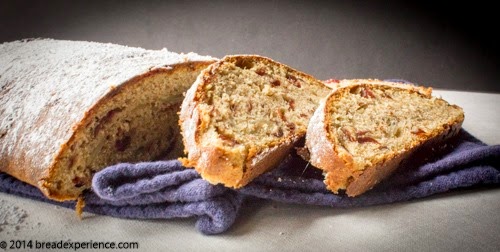
It’s beginning to look a lot like Christmas, and what would Christmas be without a traditional Holiday bread?
Stollen, a bread that originated in Dresden, Germany, is a festive loaf that represents the blanket of Jesus and is typically filled with candied fruit to signify the gifts of the Magi.
Sourdough Stollen is the bread of the month for the Sourdough Surprises baking group.
I’ve made Stollen several times: Traditional Stollen, Christmas Stollen, and BBA Stollen so this time, I wanted to try something different.
This version utilizes a sourdough starter and includes high-extraction spelt flour instead of bread flour. I used home milled whole grain spelt flour that I sifted twice to remove some of the bran and germ.
This bread can be folded and formed into a crescent shape or simply shaped into a log. Since I’ve made the crescent shape before, I opted for the log shape this time. In addition, I used dried cranberries instead of candied fruit and added fresh orange zest to boost the flavor.
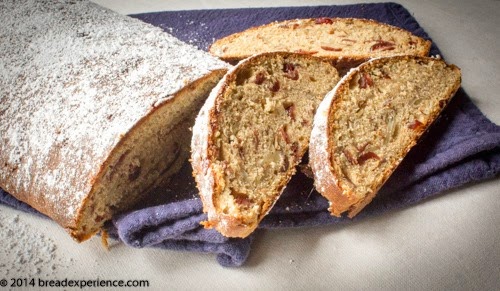
Sourdough Spelt Stollen
Sourdough Spelt Stollen for Christmas
Makes: 1 large or 2 small loaves
Adapted from: Stollen from Peter Reinhart’s Artisan Breads Every Day: Fast and Easy Recipes for World-Class Breads
Sourdough Levain:
- 3 T (42.5 grams) sourdough starter, cold or at room temperature *
- 170 grams (~1 1/3 cups) sifted whole grain spelt **
- 1/4 cups plus 3 T (100 grams) water, at room temperature
Final Dough:
- All of the sourdough levain
- 1 tablespoon (21 grams) honey
- 1/4 cup (56.5 grams) lukewarm water
- 1 teaspoon (3 grams) instant yeast
- 1 large egg, room temperature
- 3 large egg yolks, room temperature
- 1 tablespoon pure Vanilla extract
- Grated rind of 1 small orange
- Remaining sifted whole grain spelt flour **
- 1 1/4 teaspoon coarse Kosher salt
- 3 tablespoons organic sugar
- 3/4 cup (1 1/2 sticks) butter, room temperature
- 1 1/2 cups dried cranberries
- 3/4 cup slivered almonds
- Melted butter, for brushing
- Confectioner’s sugar, for sprinkling on the top
* Notes on the sourdough starter
: I used my spelt starter which had recently been fed using this method
** Notes on the flour: I started with 3 cups of whole grain spelt then I sifted it twice. I used 170 grams in the sourdough levain and the rest in the final dough. I added it in increments until the dough was sufficiently developed.
Making the Sourdough Levain:
Combine all of the ingredients in a medium bowl. Mix with a Danish dough whisk or wooden spoon until the ingredients are thoroughly incorporated. The starter should feel like a tacky or slightly sticky dough. If necessary, add more flour or water. I added a bit more water.
Knead the dough for about 30 seconds, then place it in a clean bowl and cover it loosely with plastic wrap. Let it rest at room temperature for 6 to 8 hours, or until the levain doubles in size or swells a good bit. After the rest, use it immediately, or place it in the refrigerator for up to 4 days.
I placed it in the refrigerator until the next day when I planned to bake the loaf.
The next day:
Remove the starter from the refrigerator. Cut it into 10 – 12 pieces. Place the pieces in the bowl of a stand mixer and let them warm up to room temperature.
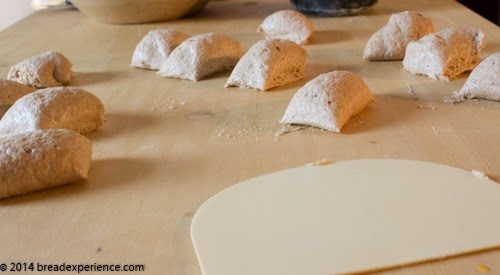
In the meantime, grate the orange zest and pour boiling water over the dried cranberries to soften them.
Once the cranberries have been plumped, drain them thoroughly to remove the excess liquid.
Making the Final Dough:
Place the lukewarm water in a small bowl and add the honey. Stir to dissolve. Whisk in the instant yeast until it is dissolved, then let the mixture rest for 1 minute. Pour this mixture over the starter pieces and stir to soften the levain.
In a separate bowl, whisk together the egg, egg yolks, grated orange rind, and vanilla. Add this mixture to the starter mixture and stir to combine thoroughly.
Add the rest of the sifted flour and the salt. Using the paddle attachment of the stand mixer, mix on the lowest speed for about 2 minutes. The dough will be wet and like a thick batter, but it should hold together. Scrape down the sides of the bowl using a spatula or dough scraper.
Continue to mix on the lowest speed and gradually add in the sugar. 1/2 tablespoon at a time. Thoroughly incorporate each addition of sugar before adding more. At this point, the dough will be smoother, but still very soft and sticky.
Increase the speed to medium-low and mix for about 5 minutes to develop the dough before adding the butter. Scrape down the sides of the bowl as necessary.
Switch to using the dough hook and continue to mix on medium-low speed. Gradually add in the butter a tablespoon at a time. Wait for each addition to be thoroughly incorporated before adding the next one. Scrape down the sides of the bowl and the hook as necessary. At this point, you can increase the speed to medium-high to speed up the process. It will take about 5 minutes to completely incorporate all of the butter. The dough will be soft, shiny, and very sticky. But if you run it through your fingers, it should be supple.
Scrape the bowl again and reduce the speed to medium. Continue to mix for about 5 more minutes to make sure the gluten is fully developed. You should be able to pull long strands of dough that look and feel like taffy.
Spelt flour does better with a shorter mix. So rather than use the stand mixer to incorporate the dried fruit, I mixed them in by hand.
Transfer the dough to a floured surface or a large bowl and add in the dried fruit. Use the fold-and-turn method to fully incorporate the dried cranberries into the dough. You may need to add additional flour to compensate for the additional liquid from plumping the dried cranberries.
At this point, the gluten didn’t seem to be sufficiently developed, so I let the dough bulk ferment for an hour with two folds at 30-minute intervals. The bulk fermentation was not part of the original process, but this dough seemed to benefit from it.
After the bulk fermentation, transfer the dough to a lightly floured work surface and dust the top of the dough with more flour.
Pat or roll out the dough into a 9-by-6-inch rectangle, or if you prefer to make two smaller loaves, divide the dough and roll each piece into a 7-by-5-inch rectangle. Incorporate more flour if necessary and use a bench scraper to help lift the dough.
Sprinkle the top with almonds. Then roll the dough up and shape it into a loaf. Pinch the seam together to seal.
Carefully place the stollen on a parchment-lined baking sheet. Using a bench scraper to gently lift the edges of the loaf before transferring it to the parchment paper helps to keep the shaped loaf intact. If you don’t have a bench scraper, a metal spatula should do.
Place the baking sheet in a cold oven. Turn the oven to 350 degrees F. Bake the loaf for 25 minutes, then rotate the pan and continue baking the loaf for an additional 25 to 35 minutes. The total baking time depends on the size of the loaf.
When it is done, the loaf should be firm to touch, sound hollow when thumped on the bottom, and rich golden brown or brown color. Keep in mind, the spelt version is darker than one made with white bread flour.
Remove the Stollen from the oven and place it on a wire rack. Immediately brush it with melted butter and dust it generously with confectioner’s sugar.
Let it cool thoroughly before serving. I let mine rest overnight (about 18 hours) before slicing and serving. However, according to the original recipe, 3 hours should be sufficient.
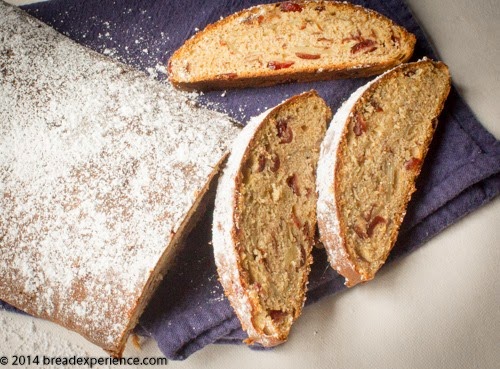
These loaves have been submitted to BYOB hosted by Carola of SweetandThatsIt.
Happy Baking!
Cathy
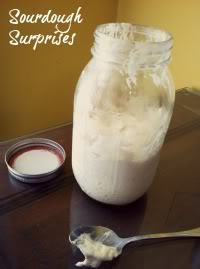
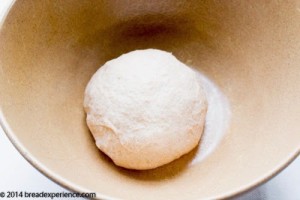
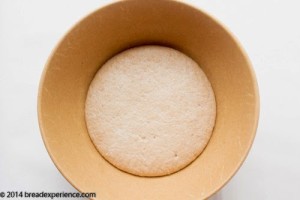
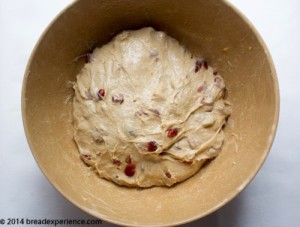
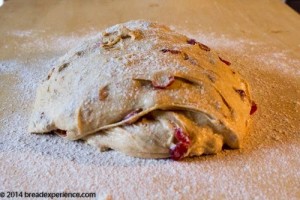
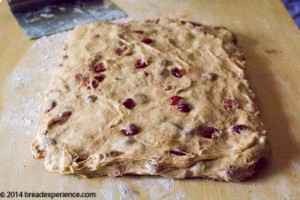
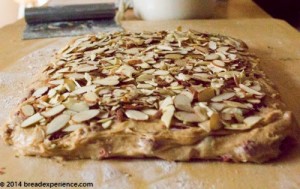
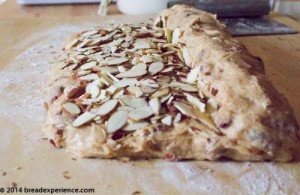
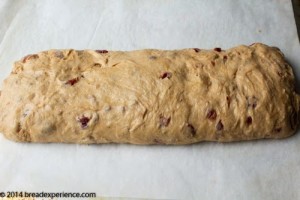
Kelster says
Nice stollen! I need to try spelt flour soon.
Cathy W. says
Thanks Kelster. Yes you do!
Mosquito Creek Farm says
Yes on the spelt flour! Looks lovely!
Cathy W. says
Thanks! It tastes great too!
Rebecca says
What a great use of spelt! Beautiful photos too.